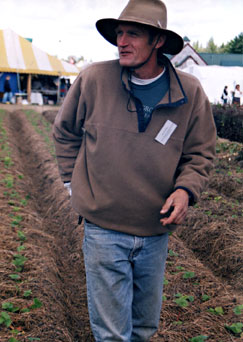 |
| Jack Kertesz spearheaded the alley cropping demonstration at MOFGA’s orchard in Unity, showing how annual and perennial crops could be interplanted in a young orchard to gain income while waiting for fruit trees to mature. |
By Jack Kertesz
Imagine working with a blank slate of ground and feeling that the outcome might look like some small, twiggy trees surrounded by an undetermined amount of green vegetation of questionable quality. Now imagine this plot of land on MOFGA’s home base, a veritable garden in a fishbowl. Such was my trepidation when I learned in January 2000 that I had received a USDA SARE (Sustainable Agriculture Research and Education) grant to explore the potential of interplanting a yet to be established orchard on the site. A year later, I can breathe a big sigh of relief as I work up seed orders and plan for planting this year. What follows is a synopsis of what synthesized and transpired on a place in Unity that many of us have come to know as Common Ground.
As a member of MOFGA’S landscape committee, I’d spent a chunk of time wondering how the ideas we eagerly exchanged at meetings would ever materialize. As a local resident, I also wondered how involved my role might get. I should have guessed, when Ron Desrosiers, a NRCS (Natural Resource Conservation Service) staffer, attended a fall meeting, that things would be greening up soon. Ron is passionate about trees, and over the years we’d shared plenty of information, encouragement and plant material. Ron asked us to consider a SARE grant, and I slowly volunteered to help write the proposal.
We chose to work under the general category of agroforestry, a melding of trees with conventional crops, and within the specific boundaries of alley cropping, the planting of mixed crops between rows of trees. I had been intrigued with the practice of alley cropping for some time. The best examples that I’d seen were of small scale operations fine tuning their landscapes to create a diverse and profitable enterprise. Here was a chance to put it to the test.
Our proposal, “Improving Financial Returns Early in an Orchard’s Life Through Alley Cropping,” was awarded an $11,100 farmer/grower grant. The following expenses were included in the two-year project:
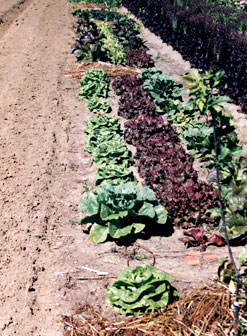 |
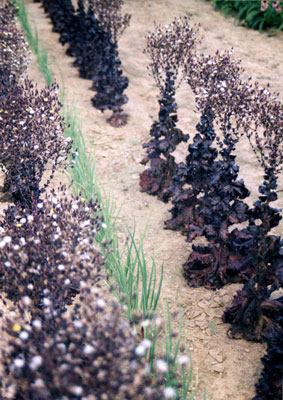 |
| A bed of lettuce yielded well, despite dry conditions. | ‘Merlot’ lettuce, on the right, was “aesthetically stunning” during the growing season and yielded a crop of seeds as well. |
• Salary for myself: $2,000
• Wages for seasonal workers: $6,000
• Trees: $600
• Seed: $900
• Soil amendments: $200
• Leasing tillage and harvesting equipment: $500
• Irrigation supplies and a backpack sprayer: $500
• Row covers and orchard supplies: $400.
Another $9,000 is expected from matching contributions of labor and materials.
The Site
The previous owner of the site had extracted numerous crops of irrigated potatoes and corn from the land. Beginning in 1997, Mark Fulford applied various soil amendments, including rock phosphate, azomite, lime and generous amounts of compost. Several light crops of green manure were also incorporated. Nonetheless, the 1.5-acre plot dedicated to the south orchard still looked “impoverished” last spring. One area did look workable, a half-acre section that had been loosened with a spading machine during the Common Ground Country Fair the previous year. Despite about a third of it showing a green beard of quackgrass (also known as “witch” or “couch” grass), I decided to plunge ahead.
Larry Ward, a local dairy farmer, spread Herbkomp compost with his equipment, and Bob Kline loosened the soil with his spader. This was soil unlike any that I had ever worked: a stone-free, silty/sandy loam. With little evidence of organic matter, it behaved erratically … puddling in a rain or when a hose was left on and then acting like a quicksand wannabe, sucking in unsuspecting feet. The surviving weeds were stunted, the soil structureless – This could be challenging. I decided on a strategy that would minimize equipment use and optimize hand labor.
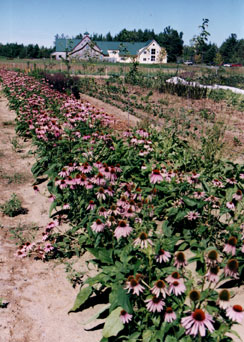 |
| Echinacea was one of several intercropped species. |
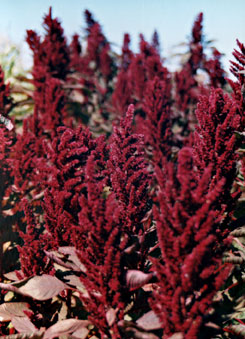 |
| Amaranth was another intercropped species. |
The Alleys
Seven alleys were determined by the spacing of trees in the orchard. Included here are apple, pear and plum on various size controlling rootstock, planted on a 20- by 20-foot grid. Two outer half-alleys are adjacent to the roadways. Apple trees on a 24- by 24-foot spacing are situated there. Five 20- by 100-foot and four 24- by 100-foot alleys with a north-south orientation were thus created.
Alley Crops
An assortment of crops was chosen to test the limitations of this site, of the grower and of the layout. Traditional crops of winter squash and dry beans fared well. Ornamental corn grew robustly but failed to mature with any reliability. A seed crop of Moon and Stars watermelon took its sweet time ripening, most of it happening after the Fair. Yields were adequate to sell to FEDCO Seeds but were paltry by commercial standards. Merlot lettuce was aesthetically stunning during the growing season. With only a single harvest for seed, its yields weren’t appreciable. Intrigued by its ornamental qualities, I will consider growing this again. A muskmelon crop barely materialized, although the few that made it to the transplanting stage and avoided cutworm damage offered some luscious fruit, putting this crop high on the 2001 priority list. A soybean crop will also be repeated based on its performance last year. Green beans, flowers, and a range of culinary and medicinal plants flourished. A bed of ornamental grains and grasses showed promise for future production. Getting them dried and cleaned proved a more formidable task.
Partly on the recommendation of another grower, I adopted a low-input strategy for tomatoes. Six varieties were left to sprawl on a mulched bed. Most had difficulty ripening in the cool and delayed season that we experienced. Jubilee had a significant fruit set and, with only a modest covering of plastic, offered ripe fruit even after a mid-October snowstorm. With a little more diligence, I believe I could have nursed a crop along into early November. Remarkably, these plants showed no signs of early blight. (I’ve since been told to expect it next year.)
Long- and short-term candidates were selected for an alley devoted to nursery crop production. Inattention to watering and mulching accounted for disappointing results in this section. I’ll be maintaining it more diligently this year, adding some new liners and larger caliper stock.
In the Tree Rows
Where weed competition was sparse, these sections were intensively planted with an emphasis on diversity. Dill, parsley, epazote, tomatillos, lettuce, and several perennials were scattered throughout the orchard. As the trees mature, the interplanted crops will evolve into a full complement of understory plants. Many will be used for habitat enhancement for predatory insects. This seemingly disorderly arrangement of plants should have a substantial payback in the orchard.
Tools and Techniques
An assortment of hand tools was used on site. A large broadfork and an ordinary five-tined manure fork were used to prepare various sized areas. Compost was spread with silage forks and grain (snow) shovels. A major portion of the site saw frequent trips with a wheel hoe and oscillating (stirrup hoe) attachment. Follow-up cultivations at short intervals with the wheel hoe and a hand stirrup hoe seemed redundant but proved invaluable in controlling weed populations. An initial thrust to remove witchgrass in selective areas by hand paid a high dividend, as no spots ever became unmanageable. A rototiller was used minimally to incorporate green manure.
Pests and Problems
Surprisingly few pests were encountered this first year. A skunk or porcupine damaged some of the corn before an electric “sheep” fence was installed. Striped ccuumber beetles and squash bugs arrived late and were knocked down with a single spray of pyrethrum, garlic and cayenne. Cutworms dined heartily on the dry beans. A scavenger hunt on hands and knees brought their population down to a reasonable level.
More pestiferous were the quirky weather patterns we encountered. Often we’d miss the rain everyone else was experiencing, getting up to a tenth of an inch of moisture-laden air instead. In late summer I learned that the previous owner witnessed the same phenomenon. On one occasion, I actually watched two separate storms diverge and go around the site. I learned to ignore forecasts and water plants when necessary. Cool summer temperatures and a frost nearly two weeks ahead of schedule have me looking seriously at cool season crops for this coming season.
Orchard Plans
The orchard committee envisions this planting as a possible model for a large home scale or small commercial operation. Scab resistant apple varieties, a mixture of fruit types and rootstocks, attention to optimizing tree and orchard health, and low equipment overhead are key components in this venture. Spraying will be done initially with a backpack sprayer and later with a trailer mounted unit attached to a small garden tractor. Interplanted nitrogen fixing shrubs and habitat enhancing plants for beneficial insects will also be maintained. More trees will be added to fill the remaining portion of this site.
The Fair and Beyond
For many staff and fairgoers, the demonstration garden was a milestone in MOFGA’s efforts to grow a permanent home. As I planned, planted and tended the crops this season, I was very aware of the dedication of a large body of individuals who have worked toward this goal. I felt privileged to be a part of this contribution and was amply rewarded with the delight of people strolling through the garden during the Fair. The energy that sustained me in my effort this past summer was sown years ago. I am thankful for being able to share the fruit of that labor on this piece of ground.
I’d like to thank the crew who contributed to the success of this garden: Steve Agius, Jeremy Kupferman, Cade Christensen and Jim Buckle. In addition, a heartfelt thanks goes out to the many volunteers and contributors who made this project possible.
The following people and businesses have donated their time and/or products to make this project happen: Fedco Seeds (seeds); Organic Growers Supply (amendments); Johnny’s Selected Seeds (seeds and gardening supplies); Herb Comp (compost); Fedco Trees (trees); Maine Seed Saving Network; Chase Toys (loan of ATV to drag in wheat seed); Part ’n Parcel Farm (plants); HerbFest vendors (plants); Amy LeBlanc (plants); Brian Bryne, Elizabeth Radliffe, Nick, Allison Wallace, Russell Libby, Rick Kip, Tom Levesque, Bob Kline, Larry Ward, Rick Kersbergen, Ernie Glabeau, Mark Fulford, Greg Johnson, Heron Breen, John Bunker, Seth Mercier, Bob Sewall, Zachary Kertesz, Zoli Kertesz, Scott Howell, Tom Vigue, Tim Christensen, John McIntire Barry Fred Robie
A much appreciated thanks to all!
